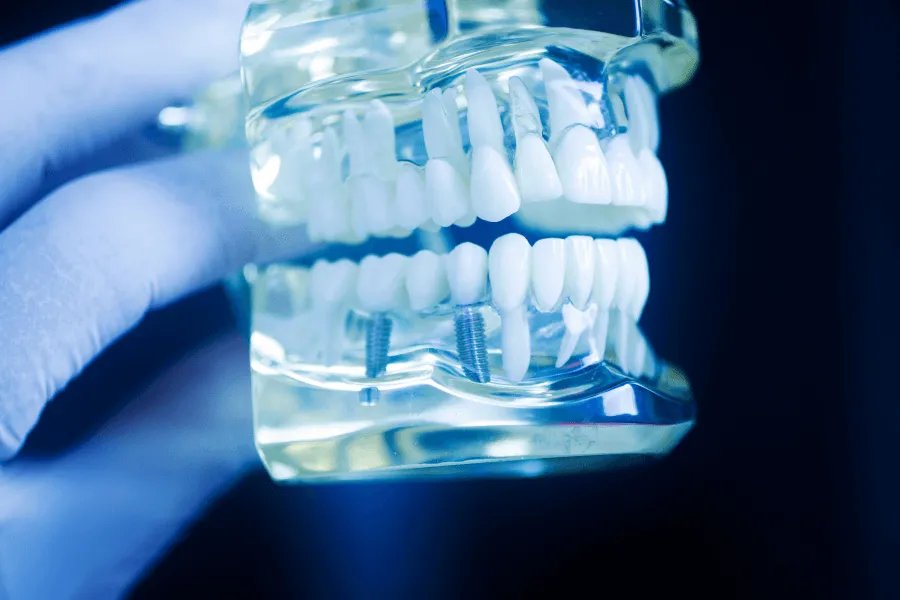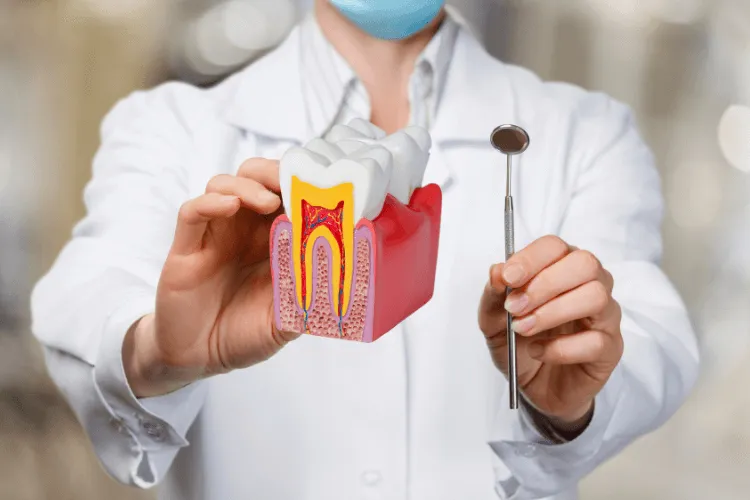Co zrobić, gdy podczas leczenia ortodontycznego odsuwają się dziąsła? Porady specjalistów ze Stomatologii Edent
Dlaczego dziąsła odsuwają się podczas leczenia ortodontycznego?
Leczenie ortodontyczne, mające na celu korektę wad zgryzu, może czasem wiązać się z różnymi niepożądanymi efektami. Jednym z nich jest odsuwanie się dziąseł, które może wystąpić u niektórych pacjentów. Choć problem ten jest stosunkowo rzadki, jego wystąpienie może budzić obawy. Stomatolodzy ze Stomatologii Edent wyjaśniają, co może być przyczyną recesji dziąseł, jakie działania należy podjąć i jak zapobiec jej pogłębianiu.

Dlaczego dziąsła mogą się cofać podczas leczenia ortodontycznego?
Recesja dziąseł, czyli ich cofanie, może wynikać z różnych czynników. Podczas leczenia ortodontycznego aparat stały lub nakładkowy wywiera nacisk na zęby, co jest niezbędne do ich przesunięcia. Jednak zbyt duża siła nacisku lub niewłaściwe ustawienie zębów może prowadzić do podrażnienia dziąseł i ich odsuwania się.
Najczęstsze przyczyny odsuwania się dziąseł:
Najczęstsze przyczyny odsuwania się dziąseł:
- Nieodpowiednia higiena jamy ustnej – Aparat ortodontyczny sprzyja gromadzeniu się płytki bakteryjnej, a jej nadmiar może prowadzić do zapalenia dziąseł i ich cofania.
- Nadmierny nacisk na zęby – Zbyt intensywne przesuwanie zębów może przeciążać tkanki przyzębia, co skutkuje ich recesją.
- Genetyka – Niektórzy pacjenci mają większe predyspozycje genetyczne do cofania się dziąseł, co może nasilać się podczas noszenia aparatu.
- Stany zapalne dziąseł – Bakterie gromadzące się wokół aparatu mogą wywoływać zapalenie dziąseł, co z kolei prowadzi do ich cofania.

Jakie objawy mogą świadczyć o cofających się dziąsłach?
Pacjenci powinni być wyczuleni na pewne objawy, które mogą świadczyć o recesji dziąseł:
- Odsłonięcie szyjek zębowych
- Zwiększona wrażliwość zębów na ciepło i zimno
- Zaczerwienienie, opuchlizna lub bolesność dziąseł
- Widoczne cofanie się linii dziąseł, zwłaszcza w miejscach objętych leczeniem
Co zrobić, gdy dziąsła cofają się podczas leczenia ortodontycznego?
Odsuwające się dziąsła to problem, który wymaga szybkiej reakcji, aby zapobiec dalszym konsekwencjom. W Stomatologii Edent doradzamy następujące kroki:

1. Skonsultuj się ze specjalistą
Jeśli zauważysz, że dziąsła zaczynają się cofać, jak najszybciej skonsultuj się ze swoim ortodontą lub periodontologiem. Specjalista oceni, czy konieczne jest zmniejszenie siły nacisku aparatu, a także wskaże metody zapobiegania dalszej recesji dziąseł.
2. Wzmocnij higienę jamy ustnej
Podczas noszenia aparatu ortodontycznego utrzymanie odpowiedniej higieny jamy ustnej jest kluczowe. Używaj specjalnych szczoteczek ortodontycznych, irygatorów dentystycznych oraz nici dentystycznej, aby dokładnie usunąć płytkę bakteryjną z trudno dostępnych miejsc. W ten sposób zmniejszysz ryzyko zapalenia dziąseł, które może prowadzić do ich cofania się.
3. Zastosuj łagodną szczoteczkę do zębów
Unikaj stosowania twardych szczoteczek, które mogą podrażniać dziąsła. Wybieraj miękkie szczoteczki lub szczoteczki elektryczne z trybem delikatnego mycia. Dzięki temu zapobiegniesz dalszemu uszkodzeniu dziąseł.
4. Regularne wizyty kontrolne
Podczas leczenia ortodontycznego zaleca się regularne wizyty u stomatologa, który monitoruje stan dziąseł i przyzębia. Kontrole te są ważne, ponieważ pozwalają na szybkie wykrycie wszelkich nieprawidłowości i zapobiegają pogłębianiu się problemu.
5. Terapia regeneracyjna dziąseł
W przypadku znacznej recesji dziąseł specjalista może zalecić zabieg regeneracyjny, np. przeszczep dziąsłowy. W Stomatologii Edent oferujemy nowoczesne metody chirurgiczne, które pomagają przywrócić tkanki dziąsłowe i zapobiec dalszemu cofaniu się dziąseł.

Jak zapobiegać recesji dziąseł podczas leczenia ortodontycznego?
Zapobieganie odsuwaniu się dziąseł jest możliwe dzięki stosowaniu kilku prostych, ale skutecznych zasad:
- Regularne szczotkowanie zębów i dziąseł – Utrzymanie czystości wokół zamków aparatu jest kluczowe.
- Używaj pasty z fluorem – Pasty z fluorem wzmacniają szkliwo i dziąsła, co zmniejsza ryzyko ich cofania się.
- Nitkowanie i płukanie – Używaj nici dentystycznych i antybakteryjnych płukanek, aby zapobiegać gromadzeniu się bakterii.
- Unikaj nadmiernego nacisku na zęby – Noszenie aparatu nakładkowego może zmniejszyć ryzyko recesji dziąseł w porównaniu z tradycyjnymi zamkami.
Podsumowanie
Recesja dziąseł podczas leczenia ortodontycznego może budzić obawy, jednak stosowanie się do zaleceń lekarza oraz utrzymanie odpowiedniej higieny jamy ustnej pomaga w zapobieganiu i kontrolowaniu tego problemu. W Stomatologii Edent dbamy o to, aby nasi pacjenci przechodzili przez proces leczenia ortodontycznego bezpiecznie i komfortowo, z minimalnym ryzykiem niepożądanych efektów. Jeśli zauważasz u siebie objawy odsuwających się dziąseł, nie zwlekaj z konsultacją – szybka reakcja jest kluczem do sukcesu w leczeniu.

FAQ
1. Czy recesja dziąseł jest odwracalna?
Tak, w początkowych stadiach cofanie się dziąseł może być odwracalne poprzez wdrożenie odpowiedniej higieny i leczenia. W zaawansowanych przypadkach konieczne mogą być zabiegi regeneracyjne.
2. Jakie są najczęstsze objawy cofających się dziąseł?
Typowe objawy to zaczerwienienie, krwawienie dziąseł, nadwrażliwość zębów na ciepło i zimno oraz widoczne odsłonięcie korzeni.
3. Czy nadmierny nacisk aparatu ortodontycznego może prowadzić do recesji dziąseł?
Tak, zbyt duży nacisk na zęby podczas leczenia ortodontycznego może przeciążać tkanki przyzębia, co przyczynia się do cofania się dziąseł.
4. Czy leczenie ortodontyczne zawsze prowadzi do cofania się dziąseł?
Nie, recesja dziąseł nie jest powszechna podczas leczenia ortodontycznego, ale może wystąpić u osób z predyspozycjami lub przy niewłaściwej higienie jamy ustnej.
5. Jakie zabiegi mogą pomóc w przypadku recesji dziąseł?
W przypadku zaawansowanej recesji dziąseł pomocne mogą być zabiegi regeneracyjne, takie jak przeszczep dziąseł, które oferujemy w Stomatologii Edent.










.webp)










.webp)















.webp)
.webp)

